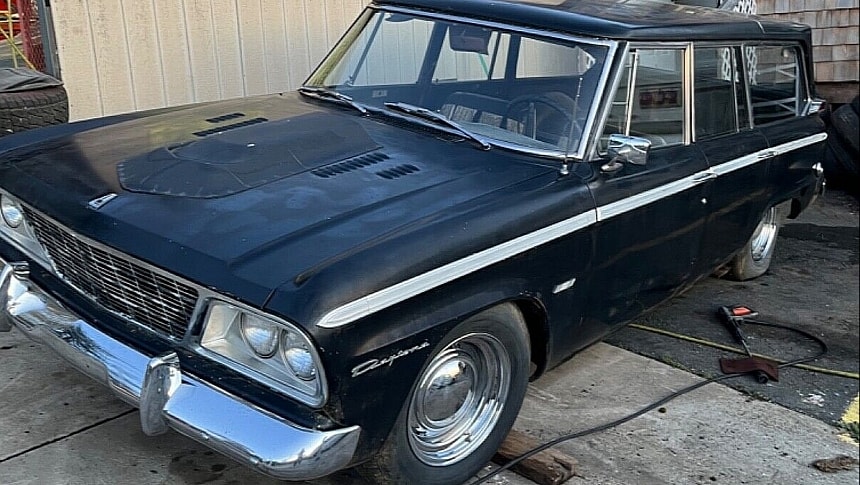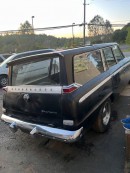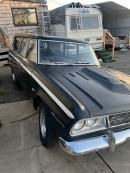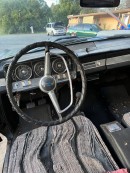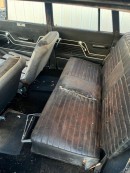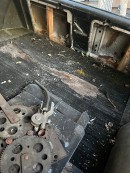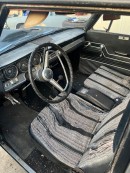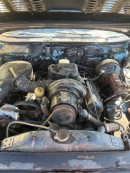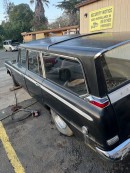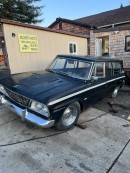Although it emerged from WW2 in strong financial shape, Studebaker was losing money by the early 1950s due to the sales war between Ford and General Motors. The company merged with Packard in 1954, but it wasn't enough to get things back on track. By 1956, the Studebaker-Packard Corporation was nearly bankrupt.
Packard was shut down in 1958, but Studebaker survived a few more years. In a final attempt to boost sales in a rough market for independent carmakers, Studebaker entered the compact market with the Lark in 1959. Three years later, the company hired industrial designer Brooks Stevens to update the car lineup on a tight budget.
Also tasked with expanding Studebaker's limited model range, Stevens designed the Wagonaire. Based on the Lark and inspired by his own 1959 Scimitar concept, the Wagonaire hit showrooms with a unique and innovative sliding roof.
Featuring a mechanism with a pair of tracks that allowed the rear roof panel to slide forward over the headliner, the retractable roof left the trunk section fully exposed. The gimmick enabled owners to haul items that would otherwise be too tall for a conventional station wagon.
A fixed roof version was rushed into production when early buyers discovered that the sliding roof leaked and the drainage tubes needed frequent maintenance to work. Studebaker moved nearly 12,000 units in 1963, the Wagonaire's first year on the market. Not only was this insufficient to help keep Studebaker afloat, but early negative reports caused sales to drop dramatically. Studebaker moved only 7,995 units through 1966, when both the company and the Wagonaire went into the history books for good.
Of the nearly 20,000 grocery-getters produced from 1963 to 1966, about 12,000 were ordered with the sliding roof. The 1964 wagon you see here is one of those forgotten gems. Recently brought out of long-term storage, this Wagonaire is one of only 5,231 haulers sold in 1964.
It's unclear how many of them left the factory with the sliding roof, but it's one of only 1,543 rigs delivered in Daytona trim, one of three versions available that year. But that number isn't very relevant because far fewer 1964 Wagonaires have survived to see 2024. Most of these grocery-getters are rotting away in junkyards as we speak.
Despite all the issues, this survivor has a sliding roof that still works. It's also a fairly complete rig that has what it takes to remain on the road without restoration for a few more years. It's unclear if the V8 still runs, but the seller says "it was running but smoked" when it was parked.
But there's good news under the hood. Because it rolled off the assembly line in 1964, this Stude packs an in-house built engine. Starting in 1965, the company began using Chevrolet powerplants. Moreover, this Wagonaire packs a supercharged V8, a rare mill in this car.
However, it's unclear if the engine is numbers-matching. The second issue is that the Supercharger appears to be an earlier McCulloch unit, not the Paxton version that Studebaker used in the 1960s. This means the Wagonaire is probably not a factory R2 car. And that's a shame because this version is super rare, with fewer than 50 units made.
But it's still a cool wagon that may be a bargain. With only 12 hours to go, the no-reserve auction shows a high bid of only $3,350. This grocery-getter is definitely worth a second chance.
Also tasked with expanding Studebaker's limited model range, Stevens designed the Wagonaire. Based on the Lark and inspired by his own 1959 Scimitar concept, the Wagonaire hit showrooms with a unique and innovative sliding roof.
Featuring a mechanism with a pair of tracks that allowed the rear roof panel to slide forward over the headliner, the retractable roof left the trunk section fully exposed. The gimmick enabled owners to haul items that would otherwise be too tall for a conventional station wagon.
A fixed roof version was rushed into production when early buyers discovered that the sliding roof leaked and the drainage tubes needed frequent maintenance to work. Studebaker moved nearly 12,000 units in 1963, the Wagonaire's first year on the market. Not only was this insufficient to help keep Studebaker afloat, but early negative reports caused sales to drop dramatically. Studebaker moved only 7,995 units through 1966, when both the company and the Wagonaire went into the history books for good.
Of the nearly 20,000 grocery-getters produced from 1963 to 1966, about 12,000 were ordered with the sliding roof. The 1964 wagon you see here is one of those forgotten gems. Recently brought out of long-term storage, this Wagonaire is one of only 5,231 haulers sold in 1964.
It's unclear how many of them left the factory with the sliding roof, but it's one of only 1,543 rigs delivered in Daytona trim, one of three versions available that year. But that number isn't very relevant because far fewer 1964 Wagonaires have survived to see 2024. Most of these grocery-getters are rotting away in junkyards as we speak.
Despite all the issues, this survivor has a sliding roof that still works. It's also a fairly complete rig that has what it takes to remain on the road without restoration for a few more years. It's unclear if the V8 still runs, but the seller says "it was running but smoked" when it was parked.
But there's good news under the hood. Because it rolled off the assembly line in 1964, this Stude packs an in-house built engine. Starting in 1965, the company began using Chevrolet powerplants. Moreover, this Wagonaire packs a supercharged V8, a rare mill in this car.
However, it's unclear if the engine is numbers-matching. The second issue is that the Supercharger appears to be an earlier McCulloch unit, not the Paxton version that Studebaker used in the 1960s. This means the Wagonaire is probably not a factory R2 car. And that's a shame because this version is super rare, with fewer than 50 units made.
But it's still a cool wagon that may be a bargain. With only 12 hours to go, the no-reserve auction shows a high bid of only $3,350. This grocery-getter is definitely worth a second chance.
